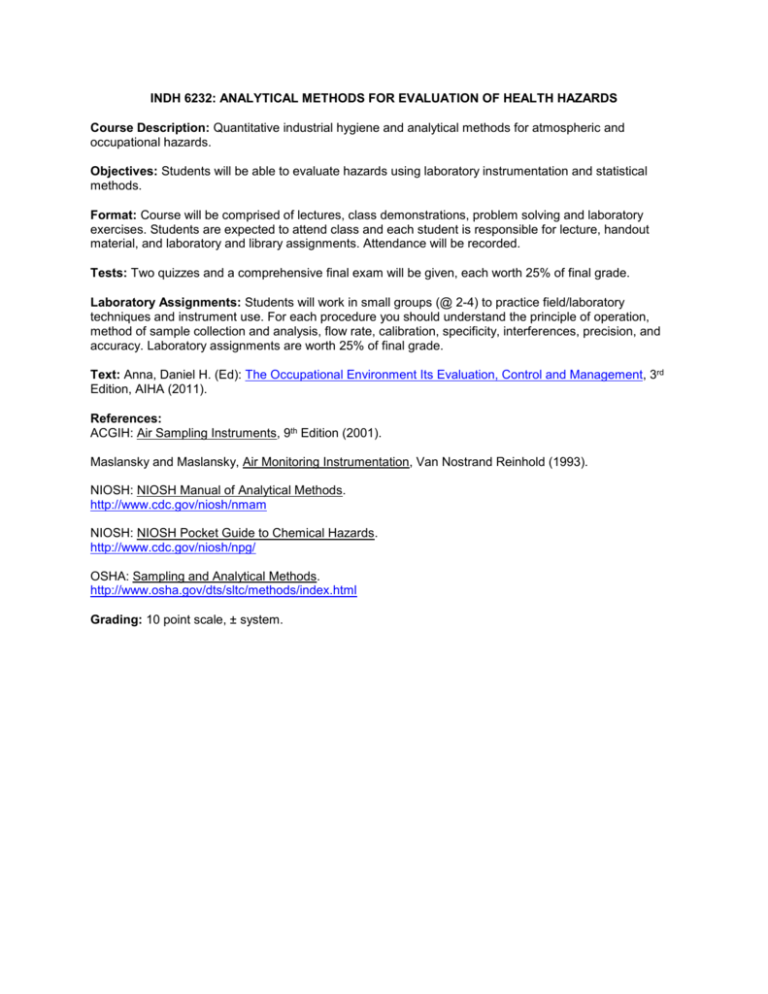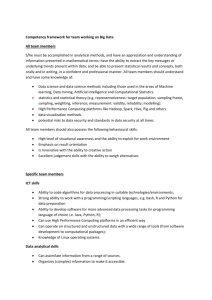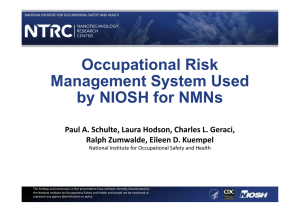analytical methods for the evaluation of health hazards
advertisement

INDH 6232: ANALYTICAL METHODS FOR EVALUATION OF HEALTH HAZARDS Course Description: Quantitative industrial hygiene and analytical methods for atmospheric and occupational hazards. Objectives: Students will be able to evaluate hazards using laboratory instrumentation and statistical methods. Format: Course will be comprised of lectures, class demonstrations, problem solving and laboratory exercises. Students are expected to attend class and each student is responsible for lecture, handout material, and laboratory and library assignments. Attendance will be recorded. Tests: Two quizzes and a comprehensive final exam will be given, each worth 25% of final grade. Laboratory Assignments: Students will work in small groups (@ 2-4) to practice field/laboratory techniques and instrument use. For each procedure you should understand the principle of operation, method of sample collection and analysis, flow rate, calibration, specificity, interferences, precision, and accuracy. Laboratory assignments are worth 25% of final grade. Text: Anna, Daniel H. (Ed): The Occupational Environment Its Evaluation, Control and Management, 3rd Edition, AIHA (2011). References: ACGIH: Air Sampling Instruments, 9th Edition (2001). Maslansky and Maslansky, Air Monitoring Instrumentation, Van Nostrand Reinhold (1993). NIOSH: NIOSH Manual of Analytical Methods. http://www.cdc.gov/niosh/nmam NIOSH: NIOSH Pocket Guide to Chemical Hazards. http://www.cdc.gov/niosh/npg/ OSHA: Sampling and Analytical Methods. http://www.osha.gov/dts/sltc/methods/index.html Grading: 10 point scale, ± system. Schedule Week 1 2 3 4 5 6 7 8 9 10 11 12 13 14 15 Topic Principles of evaluating worker exposure NIOSH Sampling Strategy Preparation of standards Calibration of sampling equipment Sampling gases and vapors Analysis of gases and vapors Spectrometry Chromatography Statistics of sampling and evaluation Problems Particles Sizing Methodologies Air sampling instruments Biological monitoring Sampling for dermal exposures Bioaerosols Midterm Exam Confined Spaces IH role in emergency response Lab preparation LAB 1 Pump calibration Total, Inhalable, and Respirable Particles Asbestos fiber counts LAB 2 Preparation of standards (gas bags) Detector tubes Portable gas detectors LAB 3 Analysis for organic vapors Activated charcoal, GC/FID/MS GC/MS Tutorial LAB 4 Metals by ICAP XRF Lab 5 MIRAN Infrared Analyzer Software: LogNorm2 Air Dispersion Models Lab Reports due Final Exam Assignment Chapter 7 Chapter 16 Chapter 15 Chapter 11 Chapter 12 Chapter 13 Chapter 14 Chapter 17 Chapter 19 Chapter 17 Chapter 46











